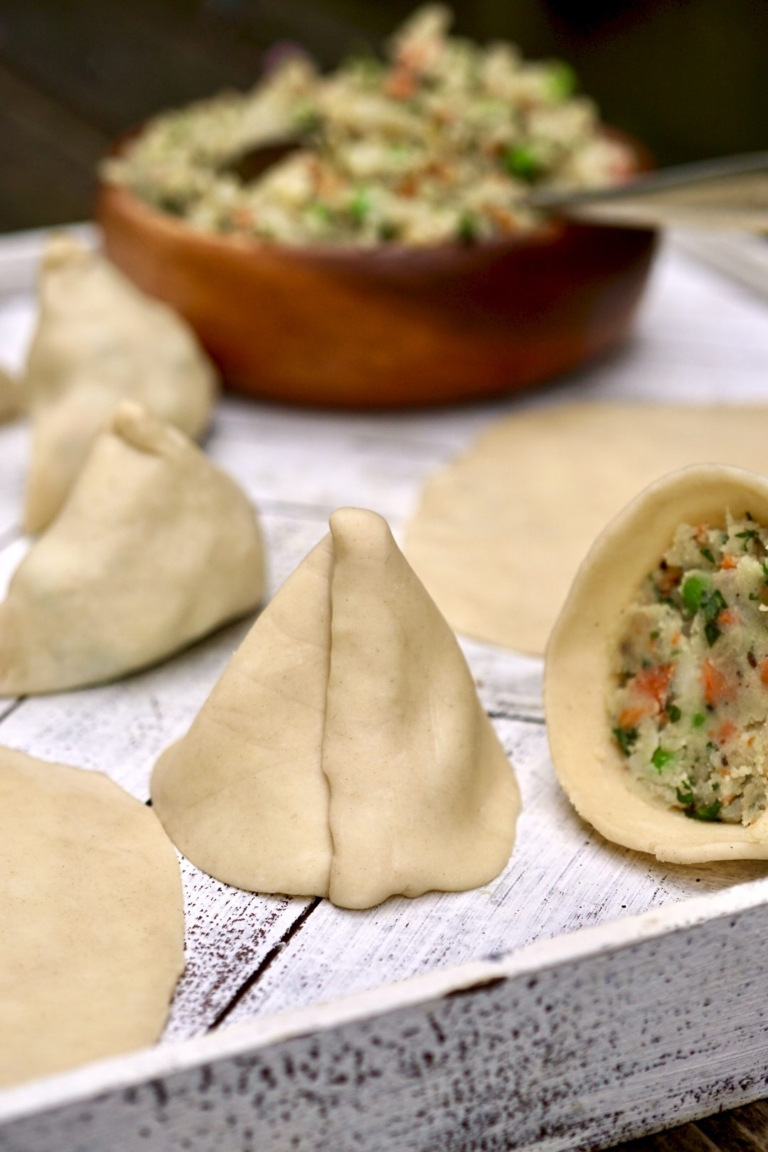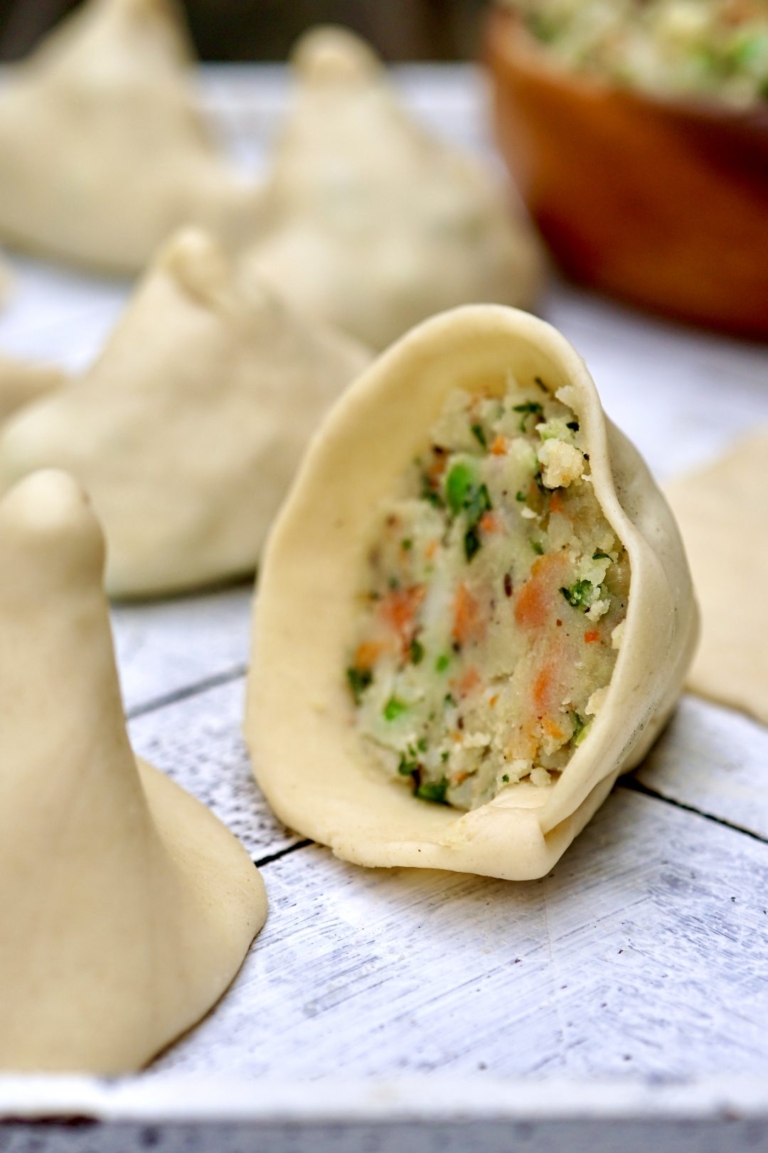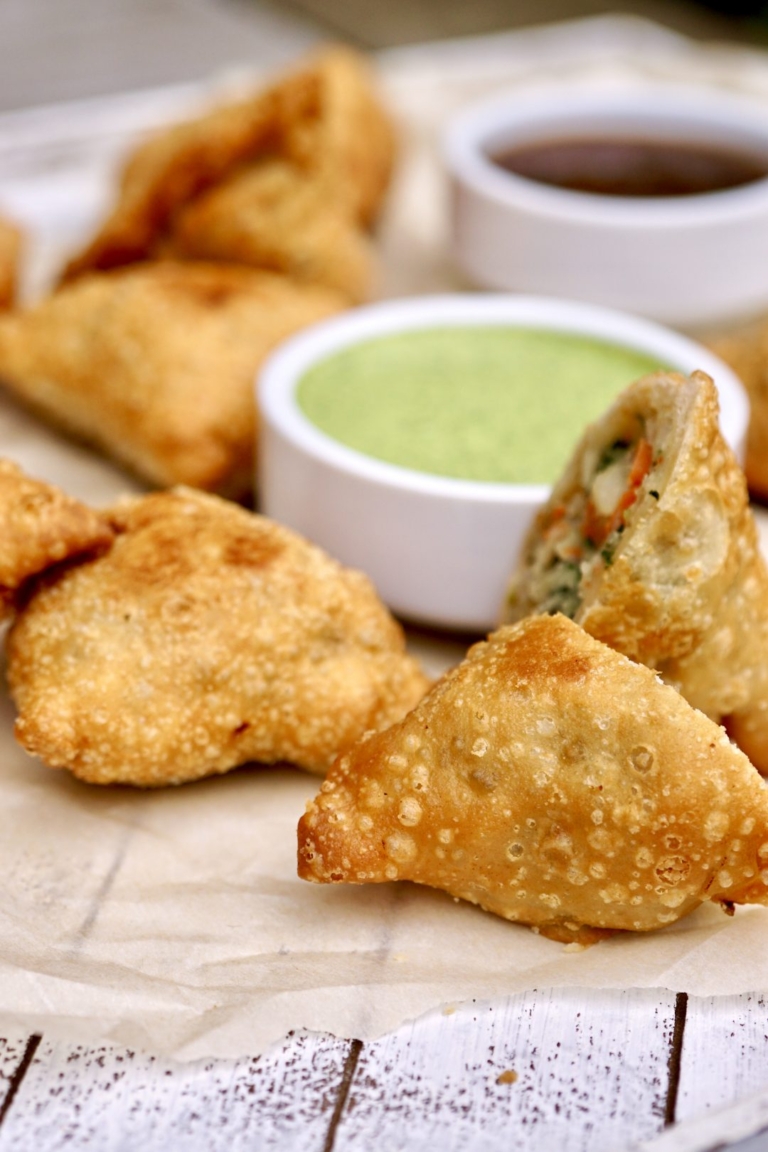Potato Samosas with Cilantro-Mint Chutney

Potato samosas are one of my favorite comfort foods. I say comfort food as these tasty, typically savory, potato-stuffed, golden-fried pastries are by no means low-calorie, but they are delightful. Samosas have been popular in South Asian cuisine for the last eight centuries and have been said to be a food that transcends both class and status across towns and cities in India and Pakistan. What is surprising to me is that samosas are not native to South Asia, they are native to Central Asia and Middle Eastern in origin.
These infamous pastries did not get introduced to South Asia until the Muslim Delhi Sultanate when cooks from both the Middle East and Central Asia came to work in the kitchens of the Sultan. After they arrived in India, samosas were adapted into a vegetarian dish and went on to become one of the most popular go-to snacks within India (due to their convenience for travel). Although commonly found in vegetarians, minced beef, lamb and chicken are also popular fillings more commonly found in North India.
Served hot, often with a side of sweet chutney, samosas are influenced by local cuisine and may not always be triangular. A popular street food version is called “samosa chaat” a popular street food in India where they are topped with yogurt, tamarind chutney, finely chopped onions, and masala making for a flavorful mouthful of contrasting textures. In parts of India that celebrate Diwali, sweet samosas are also common and often include sweetened dried fruits.
Truthfully, versions of samosas can be found all over the globe if you start looking. In Bengali, the slighter sweeter version of samosas is called “shingaras“. In Goan and Portugal, they are known as “chamucas” but are typically filled with pork, chicken, or beef. Mozambique and Brazil have versions that are referred to as “pastel”. Some Arab countries refer to their samosa version as “sambusak” and are commonly filled with meat, onion, feta cheese, and spinach. In the Horn of Africa, “sambusa” is considered a staple and served as a traditional snack during Christmas.
Once considered a specialty item, samosas are now so mainstream and have become globally famous and remain one of the most popular international foods. Because samosas are now commonly found in prepared food sections as well as frozen, traditional potato samosas are a humble comfort food with cross-cultural recognition. Despite the availability, homemade ones are to me, the very best.
Teaching myself how to make potato samosas was not as complicated as I expected, but they are slightly labor intensive. Mastering the traditional triangular shape probably took the most time, but like my chocolate dumplings, it’s just about practice and repetition. My samosa recipe is traditional both in filling and flavor and I prefer frying over baking so these are not healthy food, but they sure are tasty.
Potato Samosas with Cilantro-Mint Chutney
Ingredients:
For the Cilantro-Mint Chutney:
- 3 cups packed cilantro leaves
- 1 cup mint leaves
- 1 small Serrano chili, seeded
- 2 tablespoons cold water
- 3 tablespoons freshly squeezed lemon juice
- 1 cup plain whole fat yogurt
- Salt to taste
For the Potato Samosas:
- For the Dough:
- 3 cups all-purpose flour
- 8 tablespoons unsalted butter
- Kosher salt to taste
- 3/4 cup ice water
- 1/4 teaspoon salt
For the Filling:
- 3-4 medium russet potatoes, peeled and roughly chopped
- 2 medium carrots, roughly chopped
- 2 tablespoons canola oil
- 1 teaspoon cumin seeds
- 1/2 cup yellow onion, minced
- 1 cup frozen green peas, defrosted
- 1/4 cup cilantro
- 1 tablespoon fresh mint, finely chopped
- 1/2 teaspoon garam marsala
- 1 small Serrano chili, minced
- 2 tablespoons fresh ginger, peeled and minced
- Cilantro-mint chutney, for serving (optional)
Directions:
- For the Cilantro-Mint Chutney: Place the cilantro, mint, water, chili, water and lemon juice into the bowl of a kitchen blender, such as a Cuisinart, fitted with a metal blade. Blend on high till smooth. Add the yogurt and blend until incorporated. Add salt as needed to taste. Refrigerate until needed.
- For the Potato Samosas: For the Dough: In a food processor, such as a Cuisinart fitted with a blade attachment, add the flour, butter and salt and pulse on/off till would have pea-size crumbles. Add the water a little at a time and pulse until the dough comes together. Divide the dough into 12 equal pieces, wrap in plastic wrap, place in the refrigerator and chill for 1 hour.
- For the Filling: In a medium size saucepan add the potatoes, carrots and cover with water. Place over high heat and bring to a boil. Once boiling, reduce to a simmer and cook until tender, about 10 minutes. Drain in a colander and coarsely mash with a masher or fork. Set aside.
- Place a medium size sauté pan over medium heat. Add the cumin seeds and lightly toast till fragrant, about 1 minute. Add the onion and ginger, cook until golden, about 4-5 minutes. Remove from the heat and cool slightly. Add the cumin-mixture to the potato mixture. Stir in the peas, cilantro, mint, garam masala, chili, and salt.
- To Assemble the Samosas: Place a small bowl of cold water near your work station. Remove the dough from the refrigerator. Working with one dough ball at a time, on a lightly floured work surface, roll the dough into a 6" round; cut in half. Gather the straight edges of the half-round together, overlapping by a little to form a small cone shape. Lightly moisten the seam with water, press to seal.
- Spoon about 1 tablespoon of filling into the cone. Moisten the edges of the cone with water and gently pinch to seal. Repeat with the remaining dough balls and set aside.
- To Frying the Samosas: Line a baking sheet with paper towel and set aside. In a medium sauce pot add about 2" of oil. Place over medium-high heat until a thermometer reads 350 degrees F.
- Place 3-4 samosas in the pot at once and fry for about 8 minutes, gently turning once, until crisp and golden. Place the cooked samosas on the prepared baking sheet and repeat the above process until all the samosas have been cooked. Serve hot with a side of cilantro-mint chutney.






